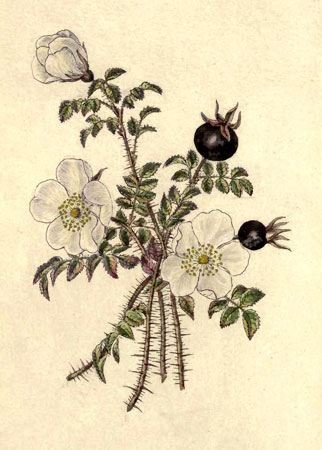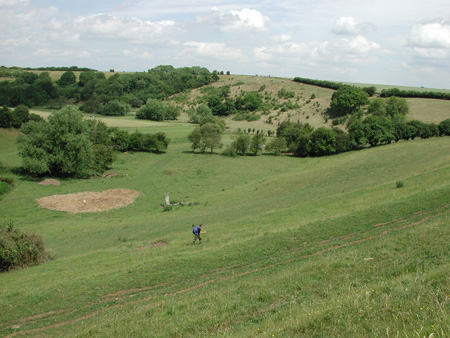However,
the 'The Towton Rose' story is not straightforward and many published accounts,
from the 19th century to the present day, are ill informed, confused and
confusing. They may describe the roses as having just white flowers or flowers
'red and white', but it unclear whether some roses were white and some red
or there was a mixture of red and white in each flower. Many old accounts
repeat previous errors without analysis or even 'embroider' them a bit more.
It is also clear that most writers had very little botanical, horticultural
or scientific knowledge or had ever seen the roses themselves!

Rosa
spinosissima (from Weeds and Wild Flowers
by Lady C.C. Wilkinson, 1858).
The Towton
Rose was generally identified as a dwarf form of Rosa spinosissima
(old name Rosa pimpinellifolia). This is a native wild rose with
various vernacular names including 'Scots Rose', 'Burnet Rose' and 'Cat
Rose'. The species is the only native rose to have dark purple/black heps
(see illustration above). All other native species have red heps. The leaves
are much smaller than other native roses and the stems bear a mixture of
narrow prickles and bristles between them. The small flowers are normally
white but forms of the species with some colour on the petals have been
recorded in various parts of Britain. Some Yorkshire nurseries sold single
coloured 'varieties' during the late 18th century.
However,
Rosa spinosissima gave rise to hundreds of single, semi-double and
double coloured Scots Rose cultivars in Scotland and elsewhere during the
early 19th century. My research embraces Rosa spinosissima and Scots
Roses from a scientific, horticultural and social history standpoint. The
Towton Rose provides a fascinating example of a particular form of Rosa
spinosissima becoming a local 'phenomenon' with supposedly magical origins
and a social history all of its own.
It is
thought that the true Towton Rose may have become extinct on the battlefield
over 60 years ago through a combination of over-collecting in the previous
hundred years, ploughing of formerly unploughed land during World War II
and the concerted effort of a local farmer to destroy the remaining roses
in the late 1940s to deter Towton Rose souvenir hunters on his land. The
Towton Rose may only survive in gardens.
My
initial enquiry to Mark Taylor [Chairman of The Towton Battlefield Society]
in May 2010 prompted a resurgence of interest in the subject. Journalist
Martin Hickes published an article called 'A new twist in the search for
the ghostly Towton Rose' in The Yorkshire Post on the 14th June 2010
and in Peter Algar's interview for BBC Radio York about his book The
Shepherd Lord in June 2010, he was asked about the search. The story
has also appeared in The Guardian and The Shropshire Star,
the latter having picked up my Shropshire connection from The Guardian
website.
This media
coverage has prompted members of the public to come forward with information
about what they hoped were true Towton Roses in their gardens. Unfortunately,
they all turned out to be Rosa gallica 'Versicolor', popularly known
as 'Rosa Mundi' (and sometimes, incorrectly, the 'York and Lancaster Rose'
which is a different rose). 'Rosa Mundi' is a widely cultivated 'Old Rose'
with irregular white 'stripes' on the dark pink/red petals. It often 'reverts'
to the dark pink Apothecary's Rose (Rosa gallica 'Officinalis').
In contrast, the true Towton Rose was the much smaller Rosa spinosissima
with pink or red markings on the white petals. The amount and intensity
of red may have varied within the population or even from one year to another.
It is
recorded that local people from Saxton sold plants of the Towton Rose to
battlefield visitors in the late 19th and early 20th century but the true
plant had already become rare by then. 'Rosa Mundi' seems to have been planted
somewhere on the battlefield at some stage (possibly around this time) and
may have been sold as the 'Towton Rose' by locals, since 'Rosa Mundi' was
easier to propagate or buy from nurseries.
I consider
that the original Towton Roses were a natural occurrence. Wild Rosa spinosissima
is still widespread in Yorkshire, particularly on the Magnesian Limestone,
but it is now extinct on some sites and less abundant than it was on others
because of changes in land use during the 20th century. It is a characteristic
rose of coastal sand dunes and such sites are now the stronghold for the
species nationally.
The history
of planting cultivated roses on the battlefield site has been extended in
the last fifteen years or so to forms of Rosa spinosissima. While
some attempts to 're-introduce' Rosa spinosissima to the site have
been unsuccessful, one planted beside the memorial cross by a member of
the Battlefield Trust flowered this year. Although I understand that this
plant was purchased with the nursery's assurance that it was native British
Rosa spinosissima, it is neither 'typical' of the species as it occurs
in Britain, nor probably as it occurs in the Towton area. I am grateful
to Scowen Sykes who kindly told me about this rose, plants of Rosa spinosissima
in Saxton Churchyard and another that he discovered in Towton village itself.
The plants at the latter two sites appear to be definitely non-native or
larger cultivated forms. Many plants of Rosa spinosissima sold in
British nurseries today originally came from taller growing European and
Asiatic sources. Such forms are very different to the dwarf roses referred
to in old accounts of the Towton Rose - not only in stature but also in
size of flowers, leaves, heps and other features.
I consider
that, if planting is done on the Battlefield area in future, it should only
be in appropriate places, with appropriate permissions and only involve
plants that have been propagated from the true Towton origin roses. Any
such plantings should be 'officially' recorded somewhere so that no confusion
arises in future.
I am very
grateful to Peter Algar and Scowen Sykes for the enthusiasm and energy with
which, separately, they have searched the battlefield area and followed
up leads on possible Towton Roses surviving in people's gardens on my behalf;
and to Graham Darbyshire for a very enjoyable day exploring the Towton-Saxton
area with Peter and myself. I am grateful to Scowen Sykes for showing me
a Rosa spinosissima that he had found in Towton itself. Other local
people have also contacted me and there are some promising leads that I
hope will culminate in the discovery of a 'true' Towton Rose before my fully
referenced article appears in the next Towton Herald!
Peter D. A. Boyd
Curator,
Shrewsbury Museums
Shropshire
Museum Service
E-mail: peter.boyd@shropshire.gov.uk
See
Peter Boyd's later article on Towton
Roses: fact and fable
for The Towton Herald (newsletter of The Towton Battlefield Society)
Winter 2010-2011
Martin
Hickes' article in The
Yorkshire Post

